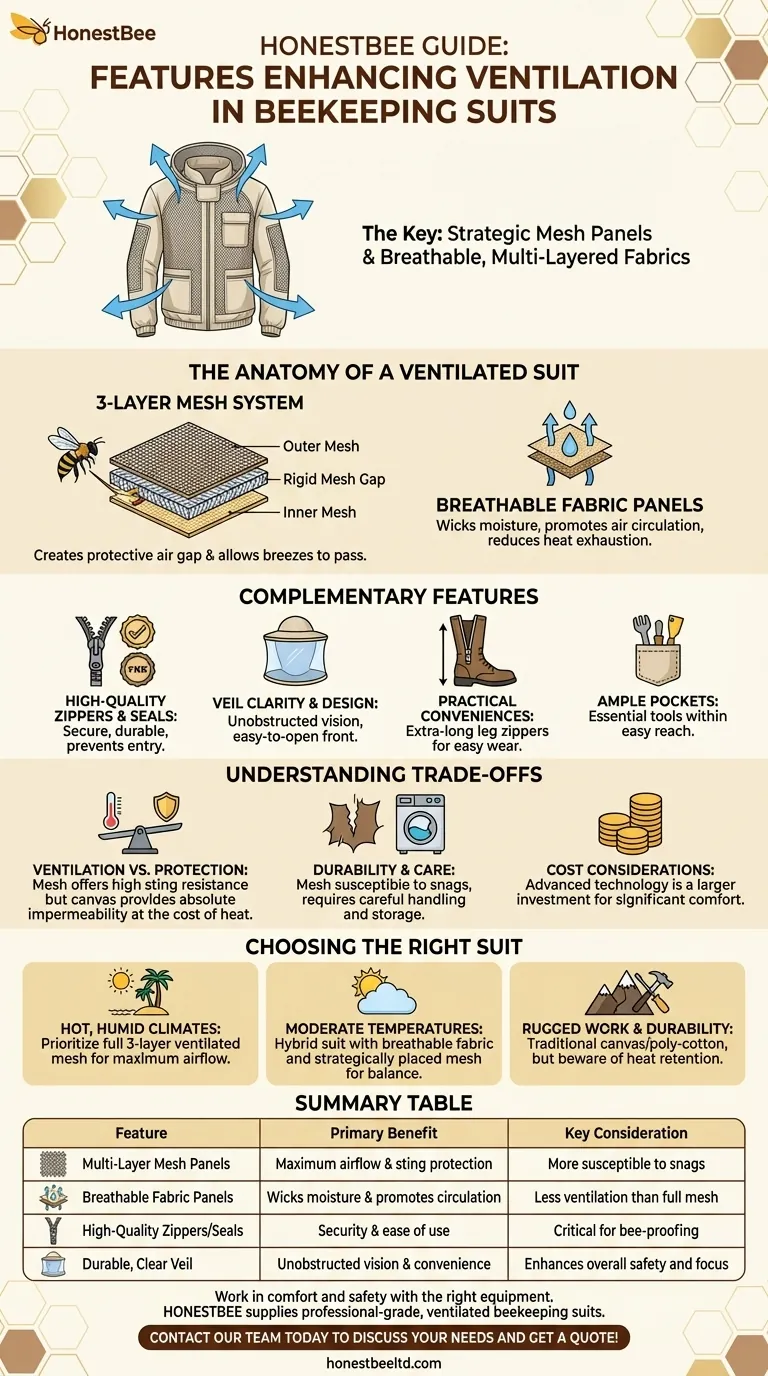The key to a comfortable beekeeping suit is its ventilation system. The most effective features are strategically placed mesh panels and the use of breathable, multi-layered fabrics. These components work together to allow air to circulate freely, which prevents overheating and allows sweat to evaporate, keeping you cool and focused during long hours with your hives.
While sting protection is non-negotiable, the true determinant of a suit's usability in warm conditions is its material science. A modern ventilated suit uses a multi-layer mesh design, not just a thick fabric, to create a protective yet breathable barrier.

The Anatomy of a Ventilated Beekeeping Suit
Understanding how ventilation is engineered into a suit helps you evaluate its effectiveness. The goal is to maximize airflow without compromising the protective barrier that keeps you safe from stings.
The Core Principle: Multi-Layer Mesh
The most significant innovation in suit ventilation is the 3-layer mesh system. This is not just a single piece of screen material.
It is a fabric "sandwich" with two outer layers of mesh and a thicker, more rigid mesh layer in the middle. This design creates a gap of air that is too deep for a bee's stinger to penetrate, while allowing breezes to pass directly through the suit.
This construction allows sweat to evaporate efficiently, which is the body's primary cooling mechanism.
Breathable Fabric Panels
In areas where multi-layer mesh is not used, the choice of fabric is still critical. Modern suits often use high-tech breathable fabrics instead of traditional heavy cotton.
These materials are designed to wick moisture away from the body and promote better air circulation than simple canvas, further reducing the risk of heat exhaustion.
Key Features That Complement Ventilation
While not direct ventilation components, other features are hallmarks of a well-designed suit that prioritizes the beekeeper's comfort and focus.
High-Quality Zippers and Seals
Look for durable YKK zippers, as they are less likely to snag or break. Overlapping zippers and secure velcro or elastic seals at the wrists and ankles are crucial for preventing bees from finding an entry point.
Veil Clarity and Design
A high-quality veil should be made of a durable and clear material that doesn't obstruct your vision. An easy-to-open front veil is also a major convenience for taking a quick drink or wiping your face without removing the entire hood.
Practical Conveniences
Features like extra-long leg zippers make it much easier to put the suit on and take it off over boots. Ample, well-placed pockets are essential for keeping hive tools, queen markers, and other necessities within easy reach.
Understanding the Trade-offs
No single suit is perfect for every situation. Choosing a ventilated suit involves balancing comfort with other factors.
Ventilation vs. Ultimate Protection
While 3-layer mesh is highly sting-resistant for most bee species, some beekeepers working with highly defensive hives may still prefer the absolute impermeability of a thick, non-ventilated canvas suit. This choice comes at a severe cost in terms of heat retention.
Durability and Care
The mesh materials used in ventilated suits can be more susceptible to snags from branches or sharp corners than heavy-duty cotton. This requires slightly more careful handling and storage to ensure the suit's longevity.
Cost Considerations
High-performance ventilated suits are generally a larger investment than basic cotton suits. You are paying for the advanced material technology that provides both protection and significant comfort in warm weather.
Choosing the Right Suit for Your Climate and Needs
Your choice should be dictated by your local climate and how you intend to work with your bees.
- If your primary focus is working in hot, humid climates: Prioritize a full 3-layer ventilated mesh suit, as it offers the maximum possible airflow and comfort.
- If your primary focus is occasional use in moderate temperatures: A hybrid suit with breathable fabric and strategically placed mesh panels offers a good balance of cost and comfort.
- If your primary focus is maximum durability for rugged work: Consider a traditional canvas or poly-cotton suit, but be fully aware of the significant heat retention and the risk of overheating.
Ultimately, the right suit empowers you to work calmly and effectively, making beekeeping safer and more enjoyable.
Summary Table:
| Feature | Primary Benefit | Key Consideration |
|---|---|---|
| Multi-Layer Mesh Panels | Maximum airflow & sting protection | More susceptible to snags |
| Breathable Fabric Panels | Wicks moisture & promotes circulation | Less ventilation than full mesh |
| High-Quality Zippers/Seals | Security & ease of use | Critical for bee-proofing |
| Durable, Clear Veil | Unobstructed vision & convenience | Enhances overall safety and focus |
Work in comfort and safety with the right equipment. HONESTBEE supplies professional-grade, ventilated beekeeping suits and equipment designed for the demands of commercial apiaries and distributors. Our wholesale-focused operations ensure you get durable, high-performance gear that keeps your team cool and protected. Contact our team today to discuss your needs and get a quote!
Visual Guide

Related Products
- White Beekeeping Protective Suit and Hat with Fencing Veil for Beekeepers
- Cotton Beekeeping Suit and Round Hat with Veil Bee Keeper Protective Gear
- Beekeeper Cowboy Hat and Veil for Beekeeping
- Heavy Duty Cowboy Beekeeper Hat with Visibility Veil Outdoor Professional Beekeeping Protective Gear
- Professional Beekeeping Suit for Kids and Girls Childrens Bee Keeper Suit
People Also Ask
- What are the essential components of a beekeeper's attire? Build Your Complete Protective System
- Why is it important to choose protective clothing with some freedom to move around? For Unrestricted Safety & Efficiency
- How should a bee suit be cleaned? Protect Your Investment and Ensure Apiary Safety
- What are the common types of protective clothing used in beekeeping? Stay Safe and Confident at the Hive
- What is the recommended maintenance for beekeeping protective clothing? Extend Gear Life & Safety



















